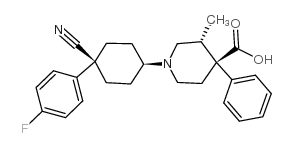79516-68-0
| Name | (3S,4R)-1-[4-cyano-4-(4-fluorophenyl)cyclohexyl]-3-methyl-4-phenylpiperidine-4-carboxylic acid |
|---|---|
| Synonyms |
Levocabastin
Livostin Levocabastina [Spanish] Levocabastinum levocabastine Levocabastina Livostin (TN) levocobastine Levocabastinum [Latin] Levocabastine [INN:BAN] UNII-H68BP06S81 |
| Description | Levocabastine (R 50547) is a potent and selective histamine H1-receptor antagonist. Levocabastine hydrochloride is also a selective, high affinity neurotensin receptor subtype 2 (NTR2) antagonist, with a Ki of 17 nM for mNTR2. Levocabastine can act as a VLA-4 antagonist, interferes with conjunctival eosinophil infiltration in allergic conjunctivitis (AC)[1][2][3]. |
|---|---|
| Related Catalog | |
| Target |
H1 Receptor α4β1 NTR2:17 nM (Ki) |
| In Vitro | Levocabastine (0-1000 μM; HEK-293 cells) causes inhibition of 125I-FN binding to the SPA bead-associated α4β1 integrin in a concentration-dependent manner with an IC50 of 406.2μm[3]. Levocabastine (0-1000 μM; 30 min; Jurkat cells and EoL-1 cells) inhibits α4β1 integrin/VCAM-1-mediated cell adhesion in vitro. Levocabastine inhibits α4β1 integrindependent adhesion of Jurkat cells to VCAM-1 with an IC50 of 395.6 μM, and the adhesion of EoL-1 cells with an IC50 of 403.6 μM. Moreover, Levocabastine inhibits adhesion of human eosinophils to VCAM-1-coated wells (IC50=443.7 μM)[3]. |
| In Vivo | Levocabastine (R 50547; 0.25 mg/kg; i.p.; twice a day for five days; guinea-pig with Parainfluenza-3 (PI-3) virus) inhibits the virus-induced airway hyperresponsiveness[1]. Levocabastine (0.05 mg/kg; i.p.; once; male C57BL/6J mice) blocks anti-stress effect ofβ-LT on mouse behavior[2]. Levocabastine (500 µg/eye; drops eye; once; ovalbumin-sensitized guinea pigs) induces allergic conjunctivitis (AC) and a significant increase of conjunctival VLA-4[3]. Animal Model: Guinea-pig with Parainfluenza-3 (PI-3) virus[1] Dosage: 0.25 mg/kg Administration: Intraperitoneal injection; twice a day for five days Result: Suppressed the influx of broncho-alveolar cells and increased in albumin content. Animal Model: Male C57BL/6J mice (8-9 weeks old)[2] Dosage: 0.05 mg/kg; 30 mg/kg (β-LT) Administration: Intraperitoneal injection; once Result: Blocked the anxiolytic effect of β-LT and decreased the number of head-dips. Animal Model: Ovalbumin-sensitized guinea pigs[3] Dosage: 500 µg/eye Administration: drops eye, once Result: Produced a noteworthy protection from allergic conjunctivitis (AC) and prevented the conjuctival elevation of VLA-4 as well as conjunctival eosinophil infiltration. |
| Density | 1.23 g/cm3 |
|---|---|
| Boiling Point | 589.9ºC at 760 mmHg |
| Molecular Formula | C26H29FN2O2 |
| Molecular Weight | 420.51900 |
| Flash Point | 310.5ºC |
| Exact Mass | 420.22100 |
| PSA | 64.33000 |
| LogP | 4.83198 |
| Index of Refraction | 1.606 |
